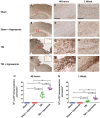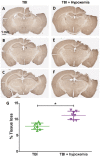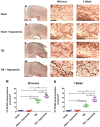Delayed Hypoxemia Following Traumatic Brain Injury Exacerbates White Matter Injury
- PMID: 27288907
- PMCID: PMC7299434
- DOI: 10.1093/jnen/nlw045
Delayed Hypoxemia Following Traumatic Brain Injury Exacerbates White Matter Injury
Abstract
Hypoxemia immediately following traumatic brain injury (TBI) has been observed to exacerbate injury. However, it remains unclear whether delayed hypoxemia beyond the immediate postinjury period influences white matter injury. In a retrospective clinical cohort of children aged 4-16 years admitted with severe TBI, 28/74 (35%) patients were found to experience delayed normocarbic hypoxemia within 7 days of admission. Based on these clinical findings, we developed a clinically relevant mouse model of TBI with delayed hypoxemia by exposing 5-week old (adolescent) mice to hypoxic conditions for 30 minutes starting 24 hours after moderate controlled cortical impact (CCI). Injured mice with hypoxemia had increased axonal injury using both β-amyloid precursor protein and NF200 immunostaining in peri-contusional white matter compared with CCI alone. Furthermore, we detected increased peri-contusional white matter tissue hypoxia with pimonidazole and augmented astrogliosis with anti-glial fibrillary acidic protein staining in CCI + delayed hypoxemia compared with CCI alone or sham surgery + delayed hypoxemia. Microglial activation as evidenced by Iba1 staining was not significantly altered by delayed hypoxemia. These clinical and experimental data indicate the prevention or amelioration of delayed hypoxemia effects following TBI may provide a unique opportunity for the development of therapeutic interventions to reduce axonal injury and improve clinical outcomes.
Keywords: Axonal injury; Brain hypoxia; Controlled cortical impact; Delayed hypoxemia; Secondary injury; Traumatic brain injury.
© 2016 American Association of Neuropathologists, Inc. All rights reserved.
Figures










Similar articles
-
Delayed Hypoxemia after Traumatic Brain Injury Exacerbates Long-Term Behavioral Deficits.J Neurotrauma. 2018 Mar 1;35(5):790-801. doi: 10.1089/neu.2017.5354. Epub 2018 Jan 12. J Neurotrauma. 2018. PMID: 29149808 Free PMC article.
-
Decompressive craniectomy reduces white matter injury after controlled cortical impact in mice.J Neurotrauma. 2015 Jun 1;32(11):791-800. doi: 10.1089/neu.2014.3564. Epub 2015 Apr 9. J Neurotrauma. 2015. PMID: 25557588 Free PMC article.
-
Imaging and serum biomarkers reflecting the functional efficacy of extended erythropoietin treatment in rats following infantile traumatic brain injury.J Neurosurg Pediatr. 2016 Jun;17(6):739-55. doi: 10.3171/2015.10.PEDS15554. Epub 2016 Feb 19. J Neurosurg Pediatr. 2016. PMID: 26894518 Free PMC article.
-
N-acetylcysteine reduces brain injury after delayed hypoxemia following traumatic brain injury.Exp Neurol. 2021 Jan;335:113507. doi: 10.1016/j.expneurol.2020.113507. Epub 2020 Oct 13. Exp Neurol. 2021. PMID: 33065076 Free PMC article.
-
The Controlled Cortical Impact Model: Applications, Considerations for Researchers, and Future Directions.Front Neurol. 2016 Aug 17;7:134. doi: 10.3389/fneur.2016.00134. eCollection 2016. Front Neurol. 2016. PMID: 27582726 Free PMC article. Review.
Cited by
-
Chemogenetic inhibition of amygdala excitatory neurons impairs rhEPO-enhanced contextual fear memory after TBI.Neurosci Lett. 2023 May 1;804:137216. doi: 10.1016/j.neulet.2023.137216. Epub 2023 Mar 28. Neurosci Lett. 2023. PMID: 36997018 Free PMC article.
-
Delayed Hypoxemia after Traumatic Brain Injury Exacerbates Long-Term Behavioral Deficits.J Neurotrauma. 2018 Mar 1;35(5):790-801. doi: 10.1089/neu.2017.5354. Epub 2018 Jan 12. J Neurotrauma. 2018. PMID: 29149808 Free PMC article.
-
modCHIMERA: a novel murine closed-head model of moderate traumatic brain injury.Sci Rep. 2018 May 16;8(1):7677. doi: 10.1038/s41598-018-25737-6. Sci Rep. 2018. PMID: 29769541 Free PMC article.
-
Recombinant human erythropoietin induces neuroprotection, activates MAPK/CREB pathway, and rescues fear memory after traumatic brain injury with delayed hypoxemia in mice.Brain Res. 2022 Nov 15;1795:148074. doi: 10.1016/j.brainres.2022.148074. Epub 2022 Sep 6. Brain Res. 2022. PMID: 36075467 Free PMC article.
-
Acute minocycline administration reduces brain injury and improves long-term functional outcomes after delayed hypoxemia following traumatic brain injury.Acta Neuropathol Commun. 2022 Jan 28;10(1):10. doi: 10.1186/s40478-022-01310-1. Acta Neuropathol Commun. 2022. PMID: 35090569 Free PMC article.
References
-
- Heron M, Sutton PD, Xu J , et al. . Annual summary of vital statistics: 2007 . Pediatrics 2010. ; 125 : 4 – 15 - PubMed
-
- Fisher MD. Pediatric traumatic brain injury . Crit Care Nurs 1997. ; 20 : 36 – 51 - PubMed
-
- Kochanek PM, Clark RS, Ruppel RA , et al. . Biochemical, cellular, and molecular mechanisms in the evolution of secondary damage after severe traumatic brain injury in infants and children: Lessons learned from the bedside . Pediatr Crit Care Med 2000. ; 1 : 4 – 19 - PubMed
-
- Chesnut RM, Marshall LF, Klauber MR , et al. . The role of secondary brain injury in determining outcome from severe head injury . J Trauma 1993. ; 34 : 216 – 22 - PubMed
-
- Chi JH, Knudson MM, Vassar MJ , et al. . Prehospital hypoxia affects outcome in patients with traumatic brain injury: A prospective multicenter study . J Trauma 2006. ; 61 : 1134 – 41 - PubMed
Grants and funding
LinkOut - more resources
Full Text Sources
Other Literature Sources

